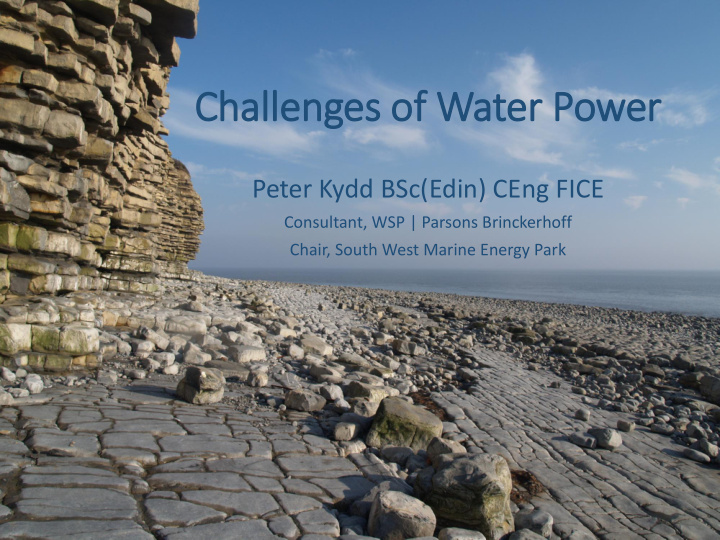



Challenges of f Water Power Peter Kydd BSc(Edin) CEng FICE Consultant, WSP | Parsons Brinckerhoff Chair, South West Marine Energy Park
My path thway in into renewable les Civil Engineering Degree in the ’ 70’s Project Manager - Water & Director of Strategic Consulting Director of Environment Hydropower Engineering Semi-retired 2006 and ongoing 1981 1989 -1991 15 years • Reservoirs and • Tidal Power • Tidal Power Pumping Stations Part of a team that • Energy White Paper 2006 • Hydropower developed the • Appointed by Gov’t to lead Shoots Barrage a Design & supervision of Severn Tidal Power Feasibility concept as an projects overseas and Study alternative to The in the UK • Policy and due diligence on many Severn Barrage different tidal power proposals • Currently advising Government on Swansea Bay and Cardiff Tidal Lagoons.
Severn Tid Tidal l Power Envir ironment, Engin ineeri ring, Poli liti tics and PR
Severn Ti Tidal Power Feasibili lity Study demonstrated that both barrages and lagoons were feasible although challenging and expensive Two Private Developers emerged: Tidal Lagoon Power with plans for Swansea Bay Tidal Lagoon – 320MW • Launched in 2011 • Awarded DCO in 2015 • Cost of £1.3bn • Awaiting other consents Hafren Power with plans for a revised Severn Barrage – 6,000MW • Launched in 2010 • Cost of £25bn • Proposed Hybrid Bill for Consents • Withdrawn in 2013
Tidal Lagoon Power’s journey shows the many hoops before any guarantee of f constructio ion • TLP are still awaiting • Conclusion of Contract for Difference negotiations with UK Government • Marine Licence from Welsh Government • Offshore Lease from The Crown Estate • Conclusions from an Independent Review of Tidal Lagoons by Charles Hendry expected by the end of this year • Other Lagoons proposed by Tidal Lagoon Power include: For more information: www.tidallagoonpower.com
Why th the in interest in in dif ifferent ty types of f renewables when th they have so so many chall llenges and reviews? 800 2030 – 2050: electrification of 2050 – Climate Total Generation Capacity (GW) transport and heat Change Act- 80% reduction in CO2 "Renewables Capacity (GW)" 700 emissions Existing Capacity (GW) 600 Units generated from Existing Capacity Gap between future (TWh/yr) 500 demand and existing Electricity Demand to 2050 (TWh/yr) supply 400 300 235GW of total capacity by 2050 200 100GW of renewables 100 by 2050 - 1970 1980 1990 2000 2010 2020 2030 2040 2050 2012 to 2050: Population Renewables Electricity: 2027 – UK Gov’t estimates (12/11): increases from Today – 15% 35-50GW of renewables, 60m to 75m 2020 – 30% 10 - 15GW of nuclear
UK Population also driving demand Ur Urbanisation Trends ONS forecasts 8% growth in population to 2021 to 68m. Biggest increases in: 100% 80% London: 14.2% 60% +11m East: 10.2% people 40% South East: 9.2% 20% East Midlands: 8.6% 0% South West: 8.3% 1950 1960 1970 1980 1990 2000 2010 2020 2030 2040 2050 Yorkshire: 7.0% United Kingdom Source: UN West Midlands: 6.8% Bris Br istol New Ho Housin ing Requirements And it continues..... 80.0 Northern Ireland 60.0 Scotland 40.0 Wales 20.0 0.0 England 2010 2015 2020 2025 2030 2035
No more coal and older plant retiring Renewables – 45TWh/yr to 160 (2030) New Nuclear – from 60TWh/yr to 100 (2030) TWh Generated per year from 2008 to 2030 Gas from 90TWh/yr to 130 (2014 to 2016) (source: DECC October 2013) CCS from 0 to 35 TWh/yr (2017 to 2030) 200.0 180.0 160.0 140.0 Coal 120.0 Coal and gas CCS Oil 100.0 Gas Nuclear 80.0 Renewables 60.0 Storage 40.0 20.0 0.0 20082009201020112012201320142015201620172018201920202021202220232024202520262027202820292030
100GW of New Capacity by 2030 (most from renewables) Renewables – 23GW by 2020 and 46GW by 2030 Gas – 10GW by 2020 and 30GW by 2030 GW of NEW Generation Plant to 2030 (source: DECC October 2013) New Nuclear – 2GW by 2020 and 10GW by 2030 CCS – 1GW by 2020 and 5 GW by 2030 120 Storage 100 Interconnectors Renewables 80 Nuclear Gas 60 Oil Coal and gas CCS 40 Coal 20 0 2013 2014 2015 2016 2017 2018 2019 2020 2021 2022 2023 2024 2025 2026 2027 2028 2029 2030 -20
Some of the Challe llenge for Renewables • Charting a long-term pathway through developing energy policy • Balancing environmental gains (carbon emissions reduction) and impacts (ecology and habitats for example) • Balancing low costs to the consumer but achieving sustainable levels of investment • Developing both the financial and economic cases • Reducing development and technology costs • Reducing the cost of capital through better management of risk • Increasing UK supply chain development and participation • The weather! These challenges are inspiring to engineering and environment professionals alike – Good luck with your studies!
Recommend
More recommend